- Bernard Preston homepage
- Arteries
- Phytochemical Foods
Phytochemical foods
Phytochemical foods are those vital plant substances that help to keep us well by reducing oxidative-stress and chronic inflammation.
They have a chemical structure known as a polyphenol; there are thousands of them and you certainly cannot, nor should you try to track whether you've had enough resveratrol or lignans, for example, today. It would drive you crazy.
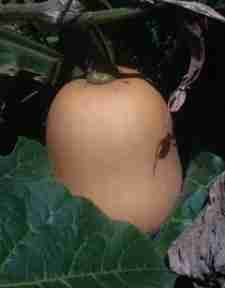
Here are a few examples of the many important phytonutrients found in coloured foods.
Greens
Orange
Red
Yellow
Purple
Stilbenes
Lutein, sulforaphanei
Carotenes
Lycopenes, quercetin
Lutein, zeaxanthin and beta-cryptoxanthin
Anthocyanins
Resveratrol
Kale, spinach and broccoli.
Butternut, sweet potatoes and citrus.
Tomatoes, watermelon and pink grapefruit.
Maize, peppers and egg yolks; and citrus too.
Beets, berries and eggplant; prunes and red grapes too.
Grapes, wine and peanuts
This page was updated on 7th March, 2025.
Of course there are many more like the allicin in onions and garlic; and flavonoids in fruits and vegetables giving them their bright colours.
These are a broad spectrum of plant substances found in virtually all fruits and vegetables; the oil-rich seeds like flax and in the olive too. Our authentic hummus recipe is particularly full of them.
Each of these compounds has its merits but their particular function in wellness is often unproven and open to speculation; yet despite their unsubstantiated status at this time, we ignore them at our peril.
These are some of them; they are terms that you may have heard but likely only vaguely. They are the substances that give onions their particular eye-watering smells, the aphrodisiac in parsley and the bright green colour in broccoli that helps prevent tumours; yellows in butternut and the purple pigment in mulberries. There are hundreds upon thousands of others.
It certainly does take a little extra time each day to drop a soaked prune into your muesli, grind some flaxseeds and to squeeze your own orange juice. It's either that or spend a great deal more consulting your doctor; paying for medicines and supplements.
Our theme at this site is making the nutritious stuff fast; perhaps an extra half an hour each day should be sufficient. Less television and social-media would do us no harm in any case.
Phyto-chemical
Phyto meaning of plant origin, of course plus a naturally-found organic chemical brings this relatively new term to the literature; but we are very familiar with them. We smell, see and consume them every day; your taste buds love them. The polyphenols in mustard and the capsaicin in peppers are yet more examples.
It is the phytochemicals in foods that underpin the strongly-researched opinion that we ought to be eating a minimum of seven coloured foods every day; and preferably ten or more. That's if we want to greatly reduce our risk of getting metastatic conditions and the risk of dying of heart disease or a stroke.
Phytochemical Foods
Phytochemical foods tells of the important nutrients in coloured fare; why the black and white diet of red-meat and potatoes is so deadly. There are over 1,000 of these substances. It would take a book to cover them properly; and new research is coming out almost daily.
Not that grass-fed red meat is necessarily bad; if you can find it. The jury is still out on that subject. Nor are new potatoes.
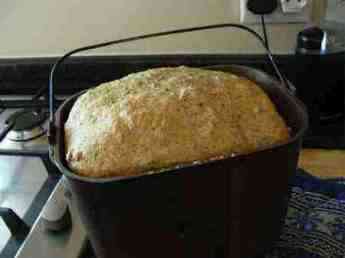
Lignans
Lignans and isoflavonoids are oestrogen-like substances found in flax, sesame seed and whole-grains; legumes like tofu and chickpeas. They are rich phytochemical foods.
Just five-minutes to make the most nutritious, light and tasty wholegrain loaf is all it takes.
In the colon lignans and isoflavonoids are broken down by bacteria into substances that are now known to protect against breast tumours for example; one helping per day of a true wholegrain reduces the prevalence by nearly fifty percent.
They are not found in flax oil; even when "lignan-enriched" it has much less than in the whole seed.
Our authentic hummus recipe is made from chickpeas, tahini and parsley; it's a balanced all-round phytochemical food. Make it yourself in just four minutes in your own home.
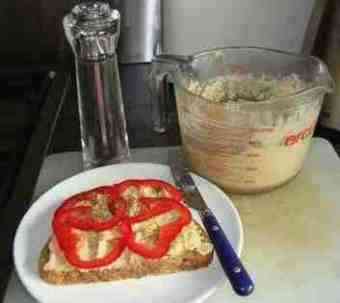
Flavonoids
Flavonoids are powerful antioxidants protecting our cells and enabling the body to mop up the free-radicals that cause neoplasms. They give our fruits, salads and vegetables their bright colours; they are plant pigments known as polyphenols.
"Antioxidants are substances that help prevent or slow the damage caused by free radicals."
- Dr Andrew Weil, M.D.
Flavonoids are important in the management of our cholesterol, blocking absorption of the bad LDL. They also increase the good high-density lipoproteins that mop up the stuff that clogs our arteries, decreasing plaque and returning them to the liver for degradation.
Flavonoids are found in fruits like grapes, the berry-family and it comes as no surprise that an apple a day is full of them; teas, tofu and broccoli too. Parsley and the onion family are rich in them; and red wine.
For example elderly women who drink at least three cups of black tea a day are one-third less likely to suffer from a hip fracture compared to those who drink it only occasionally; that is massive.
Disturbingly, adding milk completely blunts the way in which black tea dilates our blood vessels[1]; and possibly the protective effect on our bones.
These are delicious foods; we should all be indulging ourselves daily in at least of four of these treats. Feast on them.
Stilbenes
Another group of polyphenols is called the stilbenes, the most famous of which is resveratrol(2). It is found in many berries, grapes and red wine; and avocados, for example. It is known for its powerful anti-inflammatory effects.
Strong research alas has soured the taste of red wine; just one glass of commercial alcohol per week increases the risk of an invasive tumour[6]. Some are turning to home brewing.
Inflammation
The protection afforded by fruits and vegetables has clearly been shown to lower inflammatory markers such as CRP and plasma levels of homocysteine(3).
They do this by reducing the inflammatory actions of harmful enzymes in the body like Collagenase and COX. It's the flavonoids like beta-carotene and kaempferol that promote healing of fractured bones for example.
Read more at the study that finds flavonoids reduce bone-damaging inflammation[4].
Quercetin is a phenolic flavonoid found in the onion family, apples and berries for example; it is well known for its ability to mop up harmful free radicals. Research shows that it helps with immunity by affecting leukocytes; it is being promoted in capsules to assist in the fight against airway viral infections.
We recommend you rather eat a wide variety of onions, shallots and garlic; as well as apples and berries. Let your food be you medicine, as Hippocrates advocated; much cheaper and nicer.
What are phytosterols and stanols?
These are phytochemical foods found in oils from plant sources. They have cholesterol-like properties; and thus compete with lipoproteins such as LDL of animal origin at the absorption sites in the alimentary canal.
They also affect some of the inflammatory markers positively.
The best sources of stanols and sterols are avocados and extra-virgin olive oil; whole grains and nuts too.
"Some studies suggest taking 1.5 to 3 grams of phytosterols and stanols in frequent small doses daily may reduce total cholesterol levels by up to 17%. There are also suggestions that in addition they may protect against tumours."
- Dr Jenny Jamieson, MD.
Again you notice that the Big Pharma wants you to get these vital phytochemicals from pills; from your food it saves you time and money.
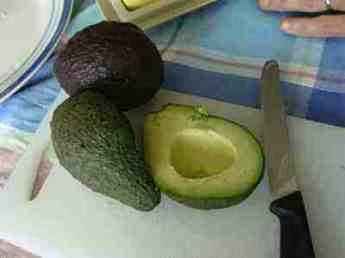
Drug and food companies have been quick to produce drugs and "enriched" margarine but the taste is not great. Food synergy suggests rather eating wholegrain breads, avocados and copious dribblings of olive oil on green salads.
Type "What are phytosterols" into the Site Search tab in the main menu above.
Terpenes
This is a very large group of phytochemical foods.
Subgroups are:
- Carotenoids
- Saponins
- Indoles and glucosinolates
- Fatty acids like those in almonds, sesame seeds and the beta-sitosterol in avos; vitamin E and the omegas too.
The only way to be getting adequate amounts of them is to be regularly eating from a wide range of foods. The "black and white" diet is deadly; like TV, turn to colour.
Carotenoids
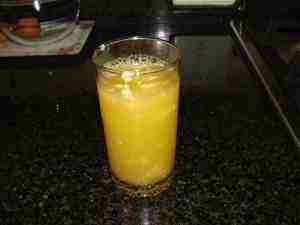
Carotenoids belong to a subgroup of the terpenes; they are also strong antioxidants. These are the colourful oranges and yellows in pumpkins and citrus; the red in a tomato and strawberry and the deep dark green of spinach, broccoli and kale benefits. The purple in mulberries and beets are found here too.
There are at least twenty different carotenoids in lemons and oranges, for example; the perfect phytochemical foods.
But the power of purple foods takes a lot of beating too.
Free-range eggs have seven times the carotenoids because of the ready access of the hens to greens; they are also the best source of choline. Our own chickens can also indulge in the fruit of the worm farms.
Carotenoids are the reason that strawberries protect the eyes from cataracts and macular degeneration. They are also in tomatoes shielding the prostate gland. Enjoy them in hot gem squash and butternut soup recipes.
In particular two carotenoids, lutein and zeaxanthin give vital protection against damaging high frequency light entering the eyes.
Lutein macular degeneration tells the story of five million needlessly blind Americans. Kale is the richest source.
Lycopene is the red colour in many foods; cooked or raw, it gives those men who enjoy a tomato a day 50% protection against prostate tumours, for example.
Type "tomato prostate" into Site Search for more information.
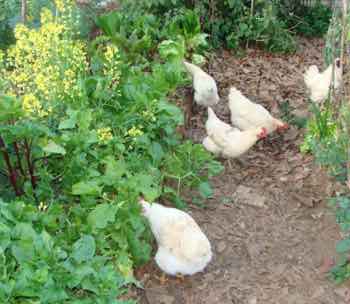
Free-range hens are into their greens; spinach, beet tops and kale to name a few. Keep half a dozen or be happy to pay a lot more for their eggs.
Saponins
Certain deadly enzymes in the gut that may cause cancer are deactivated by saponins. They are found in whole grains, many salads and fruits. Legumes and asparagus are also rich sources; and in red wine and tea, both black and green too.
Indoles and Isothiocynates
These phytochemical foods contain a very powerful antioxidant sulphur-containing substance called indole-3 carbinol.
The name's not important; known as I3C this is the substance that makes broccoli the queen of the anti-cancer foods. It is found in lesser quantities in cauliflower, cabbage and kale; and I would think lettuce too.
Another important isothiocynate in broccoli is glucoraphanin; enjoy a delicious soup recipe at broccoli facts.
Glucoraphanin is the very important precursor of the nutrient listed below for diabetics.
Xanthophylls
Xanthophylls are the yellow pigments found in many foods such as peppers, citrus and pumpkins; corn and egg yolks too. They are also found in dark-green leafy vegetables like kale and spinach.
Two particularly important xanthophylls are lutein and zeaxanthin which are found in very high concentrations in the retina of the eye; a deficiency is the prime cause of age-onset macular degeneration, the most common cause of blindness in the elderly.
Read more at lutein benefit.
They are both found together in zucchini squash.
Beta-cryptoxanthin is a carotenoid that has been shown to be particularly important in preventing age-related dementia. Citrus is one of the richest sources.
The more varied diet of a free-range hen gives higher natural xanthophylls, but the synthetic forms are added to commercial feeds.
But it's not difficult to distinguish the free-range egg from our own hens from those in cages.
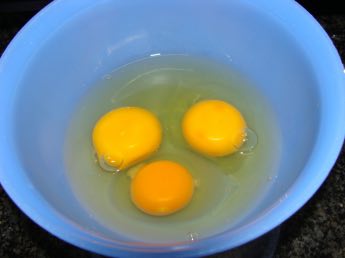
Allicin
Allicin is another member of the phytochemical foods. It's found in the onion family and especially garlic; another powerful antioxidant.
It remains controversial as some research indicates that cholesterol levels are not affected by garlic in any form, whilst other work suggests it does indeed decrease LDL.
Whilst it may not decrease LDL absorption from the gut it's been proved to reduce cholesterol production in your body. For many years garlic has been used to treat colds and to fight infections too. Read more about allicin benefits.
If you want your own allicin from the garden then take a look at growing leeks.
Oleocanthal
Oleocanthal is a phytochemical food found in unprocessed olive oil; for the record it's a phenylethanoid but forget that. It acts as a low level anti-inflammatory, working in the same way as the Cox inhibitors but without the serious side effects.
It is responsible for the burn in the back of the throat in a good extra virgin olive oil; but is extracted by processing to produce the refined forms desired by many.
Oleocanthal gives those enjoying the Mediterranean diet protection against heart conditions and Alzheimer's Disease. Researchers in France have found that it also along with lutein and zeaxanthin protects against macular degeneration.
Choline
Choline is now considered to be one of the B vitamins, so essential is it but it is yet to be numbered; so we'll include it as one of our phytochemical foods.
In humans it's a part of a vital neurotransmitter called acetylcholine and in plant cell walls.
It cannot be synthesised in our bodies so we must consume it daily; the average grocery store diet has at best half the recommended dietary allowance.
Choline food sources are important for us all; a deficiency is the cause of many diseases, including spinal cord defects in the newborn. There's at least one person with Spina Bifida in most Western schools due to poor maternal nutrition; they remain semi-paralysed for life.
Betaine is the breakdown product from choline; it is absolutely essential for the methylation of a toxic substance called homocysteine from normal protein metabolism. Those eating only a traditional grocery store food have a less than half the RDA.
Essential oils
Essential oils have long been known for their antimicrobial and fungal activities; there's heaps of scientific evidence that this is fact. They contain many different phytochemicals; I mention only two that have been shown to be highly effective against various mould spores found on food.
They are citral and eugenol; the former found in limes and lemons obviously and the latter in basil and cloves.
The importance of these phytochemicals is the prevention of food going off so quickly; many of these fungi also produce high toxic metabolites known in general as mycotoxins.
You may have heard for example of aflatoxin produced by Aspergillus flavus in peanuts and many staples such as corn and sunflower seeds; it causes stunted growth in children and liver cancer.
Some essential oils have an inhibitory action on the growth of various moulds isolated from foods.
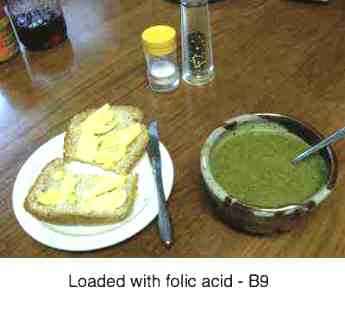
Broccoli soup
Broccoli soup remains one of the great favourites in Bernard Preston's home; she who must be obeyed made it yesterday for supper. It is loaded with many of these phytochemical foods, including folate and choline.
Chickpea burgers
So the family loves a meaty BBQ patty on a bun. Mine do too, and so do I. But with all the evidence coming out about a high red-meat diet, a vegetable burger should be an option.
The problem is that most veggie-burgers are made from soybeans. And I for one hate them. But these chickpea burgers are delicious, rich in our phytochemical foods.
To sum up
Please don't start on a not uncommon journey that I call the health nut neurosis. It makes no sense to every day start asking yourself, have I had my indoles? What about the terpenes, have I had enough of them? Ooh, I forgot about my lignans today.
Work rather in broad principles, and relax.
- Whole grain breads and unpolished rice
- An assortment of coloured fruits
- As many bright salads and vegetables as possible.
- Healthy fats, particularly from the olive, avocado and flaxseed; and fish like salmon and pilchards.
- Throw in some legumes like green beans, peas and garbanzos; and lentils too.
Newsletter
Our newsletter is entitled "create a cyan zone" at your home, preserving both yourself and Mother Earth for future generations; and the family too, of course. We promise not to spam you with daily emails promoting various products. You may get an occasional nudge to buy one of my books.
Here are the back issues.
- Lifestyle and ideal body weight
- What are ultra-processed foods?
- Investing in long-term health
- Diseases from plastic exposure
- Intensive lifestyle management for obesity has limited value
- A world largely devoid of Parkinson's Disease
- The impact of friendly bacteria in the tum on the prevention of cancer
- There's a hole in the bucket
- Everyone is talking about weight loss drugs
- Pull the sweet tooth
- If you suffer from heartburn plant a susu
- Refined maize meal and stunting
- Should agriculture and industry get priority for water and electricity?
- Nature is calling
- Mill your own flour
- Bake your own sourdough bread
- Microplastics from our water
- Alternative types of water storage
- Wear your clothes out
- Comfort foods
- Create a bee-friendly environment
- Go to bed slightly hungry
- Keep bees
- Blue zone folk are religious
- Reduce plastic waste
- Family is important
- What can go in compost?
- Grow broad beans for longevity
- Harvest and store sunshine
- Blue zone exercise
- Harvest and store your rainwater
- Create a cyan zone at your home
Follow those principles and you will have more than enough of your phytochemical foods. As a bonus, you can kiss constipation goodbye, you'll be getting plenty of the vitamins and minerals your body needs, and you will be on a low inflammation diet; less arthritis, blood vessel disease and the best protection possible against cancer. Your cholesterol doctor will be beaming and the drug companies scowling.
Is it worth an hour a day to prepare slow foods, most of them made fast? You decide.
It comes as no surprise that the proven most effective remedy against stubborn constipation is full of phytochemicals.
Grandmother's solution is the prune,
of course. It is more effective than the most frequently prescribed medication from your doctor; cheaper and nicer too.
- Type "quick constipation relief" into Site Search.
Foods that lower cholesterol
Many of these phytochemical foods have proven cholesterol-lowering properties.
Constipation
Constipation is a serious problem in today's society, provoking a host of serious large bowel and rectal diseases. Whilst phytochemical foods per se only contribute in part, they are found in those fruits and vegetables that are high in fibre.
Ask anybody enjoying a large amount of phytochemical foods, and you'll find they have no problems with their toiletries. Beetroot constipation is a favourite page, in part due to the nutrients called betalains.
Useful links
- Lorenz M., et al. “Addition of milk prevents vascular protective effects of tea.” European Heart Journal. 2007. 28(2). 219-23. Web: https://www.ncbi.nlm.nih.gov/pubmed/17213230
- Three Reasons to Eat Raw Mulberries. Web: https://www.naturalnews.com/025649_berries_mulberries_food.html
- Plasma C-reactive protein and homocysteine concentrations are related to frequent fruit and vegetable. Web: https://pubmed.ncbi.nlm.nih.gov/15051846/
- Study Finds Flavonoids Reduce Bone-Damaging Inflammation. Web: https://saveourbones.com/study-finds-flavonoids-reduce-bone-damaging-inflammation/?ck_subscriber_id=154914007
- List of phytochemicals in food from Wikipedia.
- How much alcohol causes cancer?
When browsing use right click and "Open Link in New Tab" or you may get a bad gateway signal.
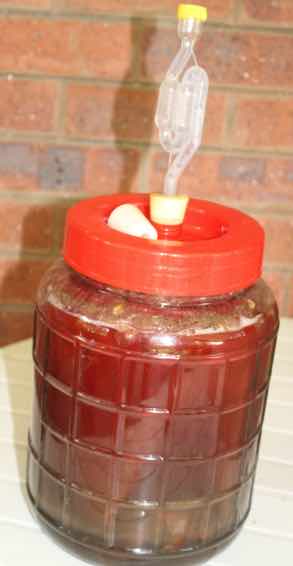 8L Catawba grape honey mead
8L Catawba grape honey meadDid you find this page interesting? How about forwarding it to a friendly book or food junkie? Better still, a social media tick would help.
- Bernard Preston homepage
- Arteries
- Phytochemical Foods
Address:
56 Groenekloof Rd,
Hilton, KZN
South Africa
Website:
https://www.bernard-preston.com